Yuchai YC135-7 Owner's Manual
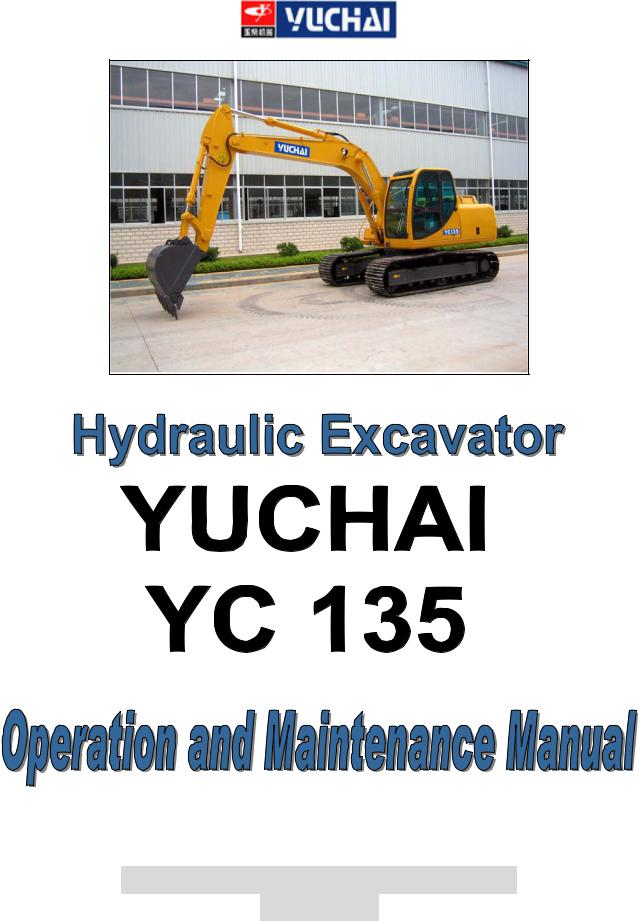
YUCHAI ENGINEERING MACHINERY CO. LTD.
Issue: 2005

ATTENTION!!!
A dangerous use of the machine may cause serious injure to the operators and to the people near the working zone. So it is essential that, who will use the machine, follows all is written in the manual. The operators and the maintainers have to read this manual before to perform any services on the machine. This manual must be kept on board to allow to the operators further consultation and periodical reading by who will use the machine.
Is absolutely forbidden use the machine inside tunnels, mines and fields with slope that exceed 30 °.
Duplication, total or partial, with any device of this manual is forbidden because it is exclusive property of the Yuchai Engineering Machinery Co. Ltd.
3

4

INDEX
1. INTRODUCTION AND GENERAL INFORMATION ............................... |
9 |
||
1.1 |
Machine serial number ........................................................................................ |
12 |
|
1.2 |
Yuchai engineering machinery co. ltd. data ...................................................... |
13 |
|
2. GENERAL PRECAUTION AND SAFETY MEASURES....................... |
15 |
||
3. PRECAUTION AND SAFETY MEASURES DURING WORK.............. |
23 |
||
3.1 |
Precautions before engine start ......................................................................... |
23 |
|
3.2 |
Precaution when the machine is working.......................................................... |
26 |
|
3.3 |
Transport precaution........................................................................................... |
37 |
|
3.4 |
Precaution when operate with battery ............................................................... |
38 |
|
3.5 |
Pulling precaution................................................................................................ |
39 |
|
4. |
MAINTENANCE PRECAUTIONS......................................................... |
41 |
|
4.1 |
Precautions before staring maintenance........................................................... |
41 |
|
4.2 |
Precaution during maintenance ......................................................................... |
44 |
|
5. |
MACHINE DESCRIPTION .................................................................... |
49 |
|
5.1 |
Excavator main parts description ...................................................................... |
49 |
|
5.2 |
Data sheet............................................................................................................. |
50 |
|
5.2.1. |
Transport blocked ......................................................................................... |
51 |
|
5.3 |
Warning plates ..................................................................................................... |
52 |
|
5.4 |
Identification plate ............................................................................................... |
54 |
|
6. INSTRUMENT AND COMMAND DESCRIPTION ................................ |
55 |
||
6.1 |
Operators seat description ................................................................................. |
55 |
|
6.1.1. |
Lever and pedal ............................................................................................ |
56 |
|
6.2 |
Instrument panel and switches........................................................................... |
60 |
|
6.2.1. |
Instrument and Switches............................................................................... |
60 |
|
6.2.2. Heating and air conditioning.......................................................................... |
66 |
||
6.3 |
Fuses .................................................................................................................... |
66 |
|
6.4 |
Operator seat........................................................................................................ |
67 |
|
6.4.1. |
Operator seat adjusting................................................................................. |
67 |
|
6.4.2. |
Seat belt........................................................................................................ |
68 |
|
6.5 |
Cabin..................................................................................................................... |
68 |
|
6.5.1. Open / Close side door ................................................................................. |
68 |
||
6.5.2. |
Front window opening................................................................................... |
69 |
|
6.5.3. |
Side window opening .................................................................................... |
70 |
|
6.5.4. |
Cab light........................................................................................................ |
70 |
|
6.5.5. |
Emergency exit ............................................................................................. |
70 |
|
7. |
STARTING MACHINE .......................................................................... |
71 |
|
7.1 |
Check before start ............................................................................................... |
71 |
|
7.1.1. Check coolant, refill it.................................................................................... |
71 |
||
7.1.2. Check and replacing engine oil ..................................................................... |
72 |
||
7.1.3. Inspecting and adjusting the fan belt............................................................. |
72 |
||
7.1.4. Fuel level and refuelling ................................................................................ |
73 |
||
|
|
|
|
|
|
5 |
|

|
7.1.5. Check hydraulic oil and refill ......................................................................... |
73 |
||
|
7.1.6. |
Check air filter ............................................................................................... |
74 |
|
|
7.1.7. |
Check electrical circuit .................................................................................. |
75 |
|
7.2 |
Starting ................................................................................................................. |
76 |
||
|
7.2.1. |
Precaution ..................................................................................................... |
76 |
|
|
7.2.2. |
Engine starting .............................................................................................. |
76 |
|
|
7.2.3. Start engine in cold weather.......................................................................... |
77 |
||
7.3 |
Operations and controls after starting............................................................... |
77 |
||
|
7.3.1. |
Engine heating .............................................................................................. |
77 |
|
|
7.3.2. |
Instrument panel check ................................................................................. |
78 |
|
|
7.3.3. Safety lock lever check ................................................................................. |
78 |
||
|
7.3.4. Noise and exhaust check.............................................................................. |
78 |
||
8. |
MACHINE MOVING RULES................................................................. |
79 |
||
8.1 |
Forward movement.............................................................................................. |
79 |
||
8.2 |
Backwards movement ......................................................................................... |
80 |
||
8.3 |
Changing direction (steering)............................................................................. |
81 |
||
8.4 |
Machine stop and park ........................................................................................ |
84 |
||
8.5 |
Swinging............................................................................................................... |
85 |
||
8.6 |
Forbidden movement and forbidden use .......................................................... |
86 |
||
8.7 |
Precaution for operating ..................................................................................... |
89 |
||
8.8 |
Work possible using hydraulic excavator ......................................................... |
92 |
||
|
8.8.1. |
Backhoe work ............................................................................................... |
92 |
|
|
8.8.2. |
Ditching work ................................................................................................ |
93 |
|
|
8.8.3. |
Loading work ................................................................................................. |
93 |
|
|
8.8.4. Operations in confined spaces...................................................................... |
93 |
||
8.9 |
How to escape from mud .................................................................................... |
94 |
||
9. |
COLD WEATHER OPERATION........................................................... |
96 |
||
9.1 |
Precaution for fuel, lubricants and coolant in low temperature ...................... |
96 |
||
|
9.1.1. |
Fuel and lubricants ........................................................................................ |
96 |
|
|
9.1.2. |
Coolant ......................................................................................................... |
96 |
|
|
9.1.3. |
Battery .......................................................................................................... |
97 |
|
9.2 |
Engine starting in cold weather.......................................................................... |
97 |
||
9.3 |
Precaution at work end in cold weather ............................................................ |
97 |
||
9.4 |
Cabin heater ......................................................................................................... |
98 |
||
10. CHECK AFTER COMPLETION OF WORK ......................................... |
99 |
|||
11. USING RUBBER SHOES (ONLY FOR MACHINE WITH RUBBER |
101 |
|||
SHOES) |
...................................................................................................... |
|||
11.1 |
Rubber shoes guarantee................................................................................... |
101 |
||
11.2 |
Precautions ............................................................when using rubber shoes |
102 |
||
12. |
TRANSPORTATION........................................................................... |
105 |
||
12.1 |
Loading ...................................................................................unloading work |
105 |
||
12.2 |
Load .................................................................................................precaution |
107 |
||
12.3 |
Precaution ...........................................................................for transportation |
107 |
||
|
|
|
|
|
|
|
|
6 |
|

13. |
MACHINE TOWING............................................................................ |
109 |
||
14. |
LONG TERM STORAGE .................................................................... |
111 |
||
14.1 |
Before storage.................................................................................................... |
111 |
||
14.2 |
During storage ................................................................................................... |
112 |
||
14.3 |
After storage....................................................................................................... |
112 |
||
15. STARTING MACHINE WITH JUMP-START CABLES (BATTERY |
|
|||
DISCHARGED!) ......................................................................................... |
113 |
|||
15.1 |
Precaution for jump-start cable connection and staring................................ |
116 |
||
15.2 |
Precaution for jump-start cables disconnecting............................................. |
117 |
||
15.3 |
Precaution for battery charging while it is onboard ....................................... |
117 |
||
16. PHENOMENA THAT ARE NOT FAILURE......................................... |
119 |
|||
17. |
THE BUCKET ..................................................................................... |
121 |
||
17.1 |
Bucket removing................................................................................................ |
121 |
||
17.2 |
Bucket assembling ............................................................................................ |
123 |
||
18. |
MAINTENANCE.................................................................................. |
125 |
||
18.1 |
Guides to maintenance ..................................................................................... |
125 |
||
18.2 |
Controls table and maintenance schedule ...................................................... |
128 |
||
18.3 |
Maintenance during Breaking-in period .......................................................... |
129 |
||
18.4 |
Lubricants (oil and grease), coolant, fuel characteristics.............................. |
130 |
||
|
18.4.1. Engine oil and hydraulic oil ......................................................................... |
131 |
||
|
18.4.2. |
Fuel............................................................................................................. |
131 |
|
|
18.4.3. |
Coolant ....................................................................................................... |
132 |
|
|
18.4.4. |
Grease ........................................................................................................ |
132 |
|
|
18.4.5. Oil and fuel storage..................................................................................... |
132 |
||
18.5 |
Filter |
.................................................................................................................... |
133 |
|
18.6 |
Electrical wiring ................................................................................................. |
134 |
||
18.7 |
Maintenance tools and torque list.................................................................... |
135 |
||
|
18.7.1. Needed tools for maintenance .................................................................... |
135 |
||
|
18.7.2. |
Standard torque list..................................................................................... |
136 |
|
19. PERIODICAL REPLACEMENT OF SAFETY CRITICAL PARTS...... |
137 |
|||
19.1 |
Daily checking or every 10 hours..................................................................... |
137 |
||
|
19.1.1. |
General check............................................................................................. |
137 |
|
|
19.1.2. Check, Clean and Replace air filter............................................................. |
138 |
||
|
19.1.3. Check coolant level and pipe preservation.................................................. |
139 |
||
|
19.1.4. |
Check bolt torque of the sprocket ............................................................... |
139 |
|
19.1.5.Checking and adjusting rubber shoes tension (for machine with rubber shoes only) 139
19.1.6.Checking and adjusting steel track tension (for machine with steel track only)
146
19.2 |
Maintenance every 50 hours............................................................................. |
149 |
|
19.2.1. |
Lubricating .................................................................................................. |
149 |
|
19.2.2. |
Check electrolyte level ................................................................................ |
150 |
|
19.3 |
Maintenance every 100 hours........................................................................... |
151 |
|
|
|
|
|
|
|
|
7 |

|
19.3.1. Cleaning fuel filter and water separator ...................................................... |
151 |
|
|
19.3.2. |
Fan belt adjusting........................................................................................ |
152 |
19.4 Maintenance every 200 hours........................................................................... |
153 |
||
|
19.4.1. Replacing oil engine and oil filter cartridge ................................................. |
153 |
|
|
19.4.2. Check and refill oil in the sprocket .............................................................. |
155 |
|
|
19.4.3. Oil level in swing gear ................................................................................. |
156 |
|
|
19.4.4. Cleaning water separator filter .................................................................... |
156 |
|
19.5 Maintenance every 400 hours........................................................................... |
158 |
||
|
19.5.1. |
Check intake pressure ................................................................................ |
158 |
|
19.5.2. Fuel filter cartridge replacement.................................................................. |
159 |
|
|
19.5.3. Check and clean radiator fins...................................................................... |
159 |
|
|
19.5.4. Replacing the hydraulic oil return filter ........................................................ |
160 |
|
|
19.5.5. Replacing pilot filter cartridge...................................................................... |
161 |
|
|
19.5.6. Engine bolts supports tightening ................................................................. |
162 |
|
|
19.5.7. Replacing the air filter cartridge .................................................................. |
162 |
|
|
19.5.8. |
Sprocket bolts fastening.............................................................................. |
162 |
|
19.5.9. Oil level in the front idler ............................................................................. |
163 |
|
19.6 Maintenance every 800 hours........................................................................... |
164 |
||
|
19.6.1. Cleaning and replacing cooling system....................................................... |
164 |
|
|
19.6.2. Replacing the hydraulic oil and cleaning the suction strainer...................... |
166 |
|
|
19.6.3. Replacing the travel motor gear oil ............................................................. |
168 |
|
|
19.6.4. Replacing swing system oil......................................................................... |
168 |
|
|
19.6.5. Check the engine valves clearance, adjusting them ................................... |
168 |
|
20. |
HYDRAULIC SCHEME....................................................................... |
169 |
|
21. |
ELECTRICAL SCHEME ..................................................................... |
171 |
|
22. |
TROUBLE SHOOTING....................................................................... |
173 |
|
23. |
OPTIONAL ACCESSORIES............................................................... |
177 |
|
23.1 Safety precaution............................................................................................... |
177 |
||
24. |
NOTICE............................................................................................... |
179 |
|
25. |
ANALYTIC INDEX .............................................................................. |
181 |
|
8

1. INTRODUCTION AND GENERAL INFORMATION
This manual provide regulations and orientations which will help you to use correctly your machine without any risk.
Keep the manual easy to read to allow all operators to read it periodically.
If the manual will miss or become unreadable, please ask for a copy to YUCHAI ENGINEERING MACHINERY CO.
LTD.
If you sell the machine, deliver the manual to new owner.
Machine project improvement could cause changing on the machine without manual updating. Check from YUCHAI ENGINEERING MACHINERY CO. LTD. For the latest information about your machine o for any question about information inside this manual.
GENERAL INFORMATION
•the improperly use and maintenance of the machine may cause hazards e could cause serious injury or death.
•Machine’s operators and maintainers have to read this manual from the first to the last page, before to start any work.
•Some action relative the machine’s functioning and maintenance may cause serious injures if they aren’t carried out likewise is described in this manual.
•Procedure and precaution described in this manual are applicable only at the expected machine use. If you use the machine for any different scope here mentioned but doesn’t specifically forbidden, you have to be sure that it is safe for you and all others.
•Never you can use the machine for any scope specifically forbidden in this manual.
9

Most of the accident and injuries that happens in the factories, agricultural firms, homes or on the roads are due to the lack of attention to any simple but basic rule of caution and safety. For this reason, most of them could be avoided: just forecast all predictable cause and act with the necessary caution.
With any kind of machine, anyhow projected and assembled, it is impossible to exclude an accident without negative interference on some essential characteristics (accessibility, efficient working, etc.).
Pay attention to all warnings written on the followed chapters and to all “PRECAUTION AND SAFETY MEASURES”.
An operator who pay attention at his work is the best guarantee against injuries.
The most representative of the safety rule is:
Never clean, lubricate or make service if the machine or part of it are working.
To avoid injuries read, comprehend and forward all precautions and warnings written in this manual and on board.
To identify the safety message, they will be highlight with the follows symbols.
DANGER
This picture is used where a residual risk with concrete possibility of permanent injury or death will remain. The messages describe safety cautions which have to be taken to avoid residual risk. The fail of comply with all is written here can, also, damage the machine.
ATTENTION
This picture is used where a residual risk with concrete possibility of moderate injury will remain.
This picture could be used also where the only residual risk is to damage the machine.
10

The YUCHAI ENGINEERING MACHINERY CO. LTD. cannot predict each circumstance which may cause a residual risk during work and/or maintenance, therefore the safety messages written in the manual can not include all safety precaution.
If you decide to make any action which is not specifically allowed o forbidden, you must evaluate every consequence to the action in order to avoid damages to people, machine or object around.
If the machine is used for a work which is not listed in this manual, the YUCHAI ENGINEERING MACHINERY CO. LTD. will not assume any responsibility about damage or injury to people and/or object.. All safety aspect in those action are under user responsibility.
All forbidden action in this manual never have to be made in any circumstance.
SPECIFIC USE:
This hydraulic excavator made by YUCHAI ENGINEERING MACHINERY CO. LTD. is drawing and realized to be used for followed jobs:
•Excavator jobs (ditches and/or canals, foundation excavation, etc.);
•Loading jobs.
The YUCHAI ENGINEERING MACHINERY CO. LTD. deny liability for possible damage to people and/or object due to different use from those above mentioned or anyway do not specifically mentioned in this manual.
MACHINE RUNNING IN PERIOD:
Your machine has been regulated and checked by YUCHAI ENGINEERING MACHINERY CO. LTD. Anyway, start with hard jobs and critical condition may have a negative influence on the machine’s performance and reduce the lifetime.
Be sure to respect the running in period for the first 100 hours (like is showed on the hours meter).
During the running in period:
•do run the engine at the low idling speed for 5 minutes before start work;
•avoid jobs with heavy load or high speed;
•avoid starts, braking, manoeuvres and unexpected stop except for emergency.
11

1.1 MACHINE SERIAL NUMBER
Fill the serial number of your machine into the followed form. If you need assistance please contact the YUCHAI ENGINEERING MACHINERY CO. LTD. service, then specify model kind and serial number of you machine.
MACHINE KIND AND REGISTRATION NUMBER
KIND/MODEL:
REGISTRATION No.:
The plate where is written the machine registration number is installed on front side.
ENGINE KIND AND REGISTRATION NUMBER
KIND/MODEL:
REGISTRATION No.:
HYDRAULIC MOTORS KIND AND REGISTRATION NUMBER
TRAVELLING ENGINE
MODEL:
REGISTRATION No.:
ROTATING ENGINE
MODEL:
REGISTRATION No.:
12
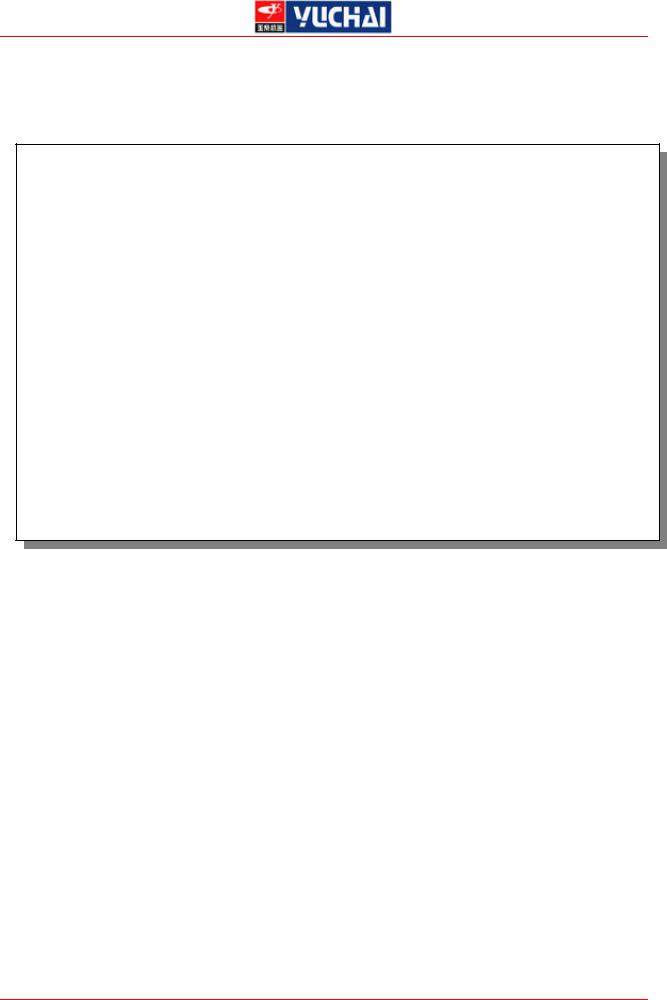
1.2 YUCHAI ENGINEERING MACHINERY CO. LTD. DATA
YUCHAI ENGINEERING MACHINERY CO. LTD.
Manufacturing Base:
168 Tianqiao Road, Yulin, Guangxi, 537005 P.R. China
Export Department Office:
36 Cuizhu Road, Guilin, Guangxi, 541002 P.R. China
Tel: 0086-773-5588521 5588522 5588523
Fax: 0086-773-5588530
E-mail: export@yuchai-excavator.com
Web-site: www.yuchai-excavator.com
YUCHAI EUROPE:
Address: V. Del Fonditore, 14 40138 Bologna, Italy
Tel:0039
Fax:0039
E-mail: europe@yuchai-excavator.com
13

14
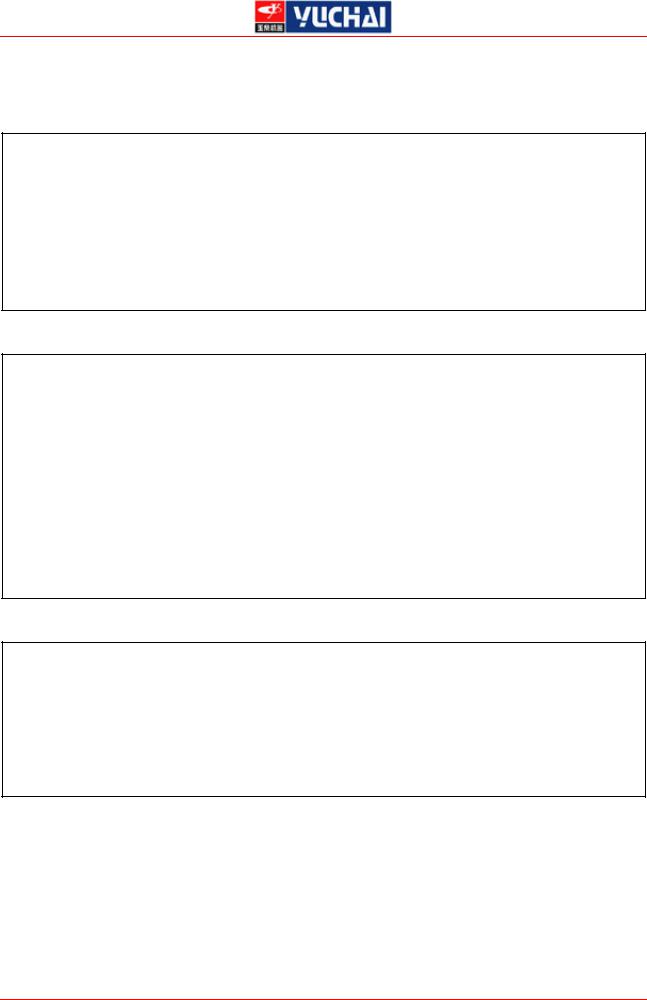
2. GENERAL PRECAUTION AND SAFETY MEASURES
FOLLOWS THE SAFETY REGULATIONS
•ONLY trained, qualified, and authorized operator can drive the machine and make maintenance.
•Follow all safety regulations, precaution and instruction written in this manual when you use or make service on the machine.
•When you work with a person who assigned to working zone traffic, be sure that he understand all hand signal used.
SAFETY CHARACTERISTICS
•Be sure that all protections and cover will be on their correct position. If the protections or cover are damaged they must be repaired and/or replaced.
•Use correctly all safety system and device installed on the machine, like the lock lever and the seat belt.
•NEVER remove any safety system and/or devices.
•Be sure that they will remain EVER in good condition.
•Unexpected use of the safety system and/or devices may cause serious injuries or death.
NON ALLOWED MODIFICATION
•Each modify made without YUCHAI ENGINEERING MACHINERY CO. LTD. authorization may cause risk.
•YUCHAI ENGINEERING MACHINERY CO. LTD. deny liability for possible injures or damage to people or objects due to non allowed modification.
15
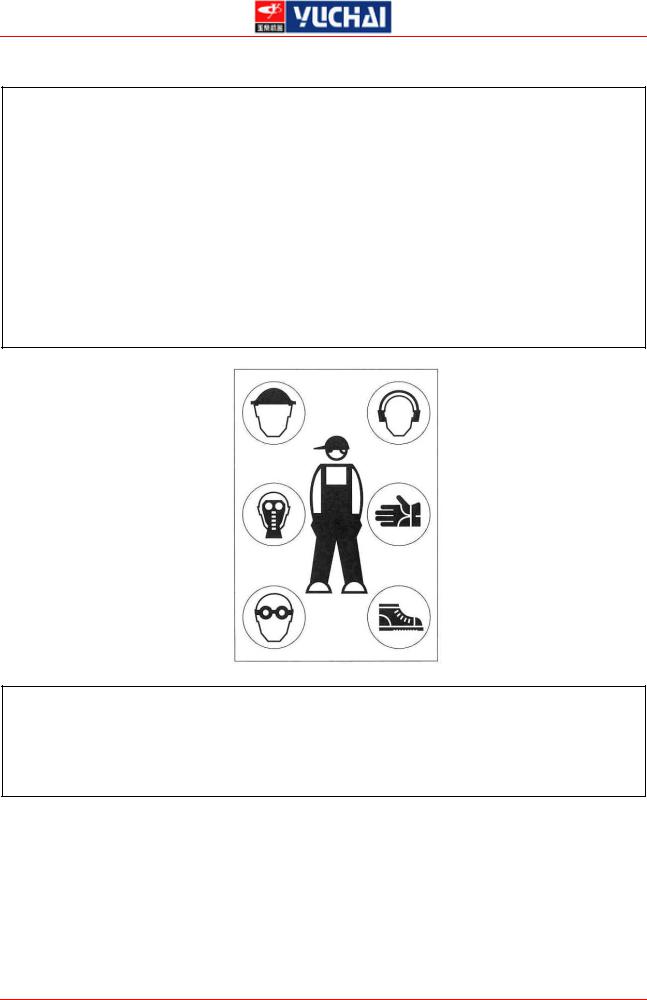
CLOTHES AND INDIVIDUAL PROTECTION DEVICES
•Avoid swirling clothes, jewels and streaming hair. They could trap themselves on the lever or floating part and cause serious injures. Also do not wear oiled clothes because they are flammable.
When drive or make service on the machine, wear a tight cap, protective eyeglass, safety shoes, filter mask, and heavy gloves. Wear always safety glasses, hard hat and heavy gloves if your job entails metal flakes or tiny materials, specially when you are hammering a hinge or are cleaning the air filter with compressed air. Also make sure that nobody stand close the machine.
•In order that the machine work in total safety is necessary the full operator’s attention. Do not wear headphones for radio or music during work.
16
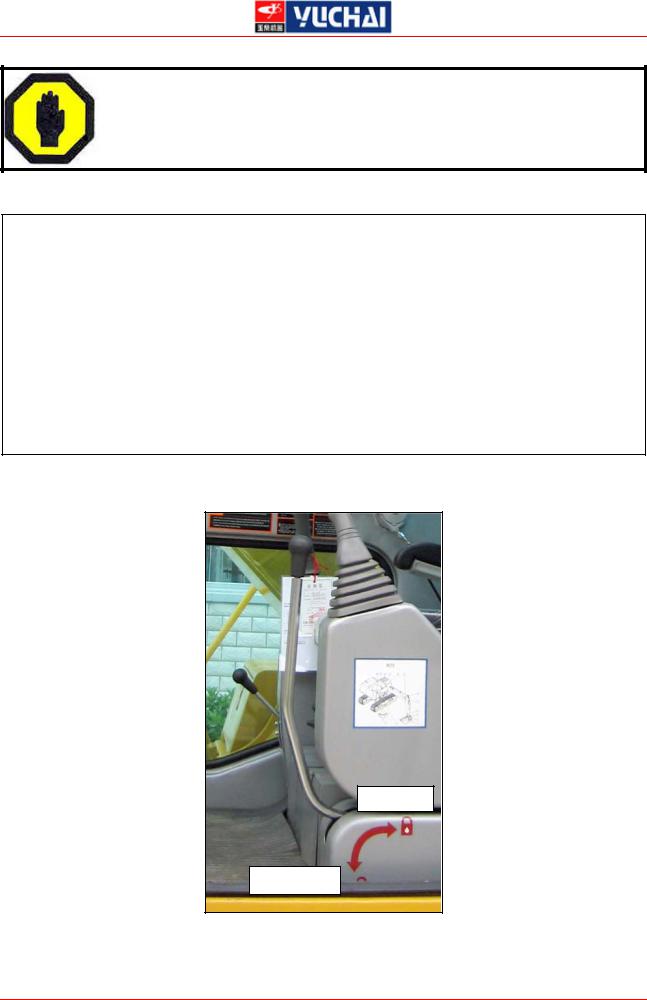
INDIVIDUAL PROTECTION DEVICES (IPD)
If you do not follow these safety precautions it may cause severe accident.
SET THE SAFETY LOCK LEVER BEFORE LEAVING THE SEAT
•When you are leaving the operator’s seat, set the safety lock lever securely to the lock position. If any controls should be touched accidentally when the safety lock lever has not be locked, the machine will move suddenly and cause severe injury or death.
•When you are leaving the operator’s seat, low the bucket on the ground (see paragraph “MACHINE STOP AND PARK”) then set the safety lock lever in lock position. Then turn off the engine and lock the cabin door (if your machine has a cabin). Take off the start key and keep it always with you.
Lock
Unlock
17
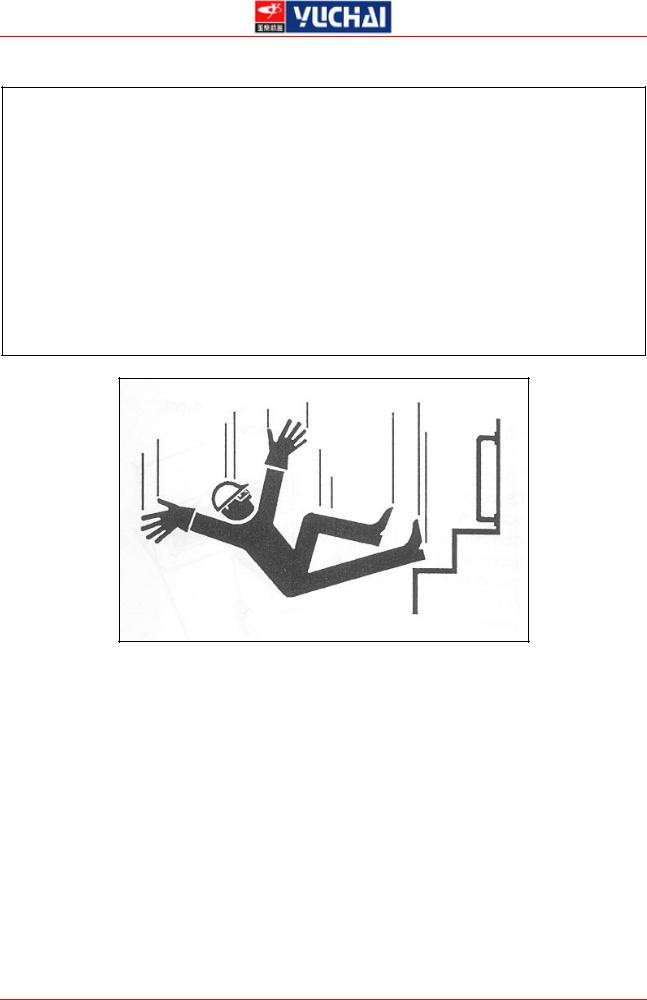
MOUNTING AND DISMOUNTING FROM THE MACHINE
•NEVER jump on or off the machine.
•NEVER attempt to mount or dismount from a moving machine.
•When mounting or dismounting the cab, always face the access system and maintain the contact with hand holds and steps while getting on or off the machine.
•Never use the safety lock lever or control levers as hand holds.
•Always maintain three contact with hand holds and steps.
•Always clean out oil or mud from hand holds and steps. If they are damaged then repair them, also close every bolt slackened.
•NEVER climb on the engine bonnet. It can put you in danger.
18
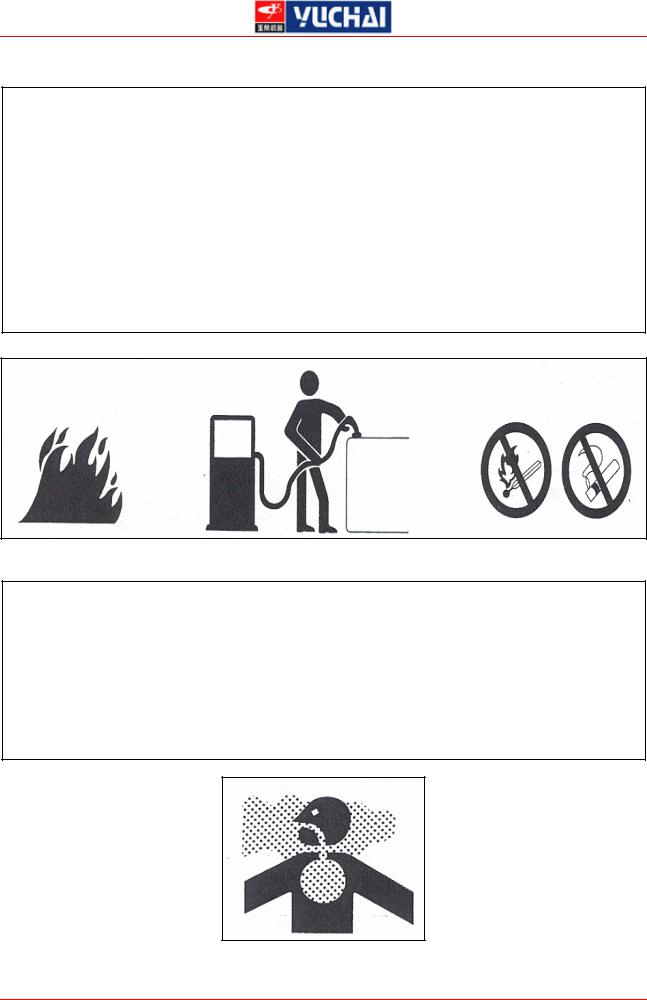
OIL AND FUEL FIRE PREVENTION
•Fuel, oil and antifreeze liquid may burst into flames if become in touch with a flame. Specially, the fuel can be very DANGEROUS because it is highly FLAMMABLE.
•Keep the flammable liquids off from the free flames.
•Turn off the engine and do not smoke while refuelling.
•Screw down as well the oil and fuel top.
•Fuel and oil refuelling must be done in well aired place.
•Take shelter oil and fuel and keep them out of reach of unauthorized people.
PREVENT ASBESTOS INHALATION HAZARD
Asbestos inhalation may cause lungs cancer.
If asbestos fibres are in your working area, follow these rules:
•NEVER use compressed air to clean anything.
•Use water to keep down the dust.
•If possible, work with blow wind from your rear.
•If possible, use a mouth-mask approved.
19
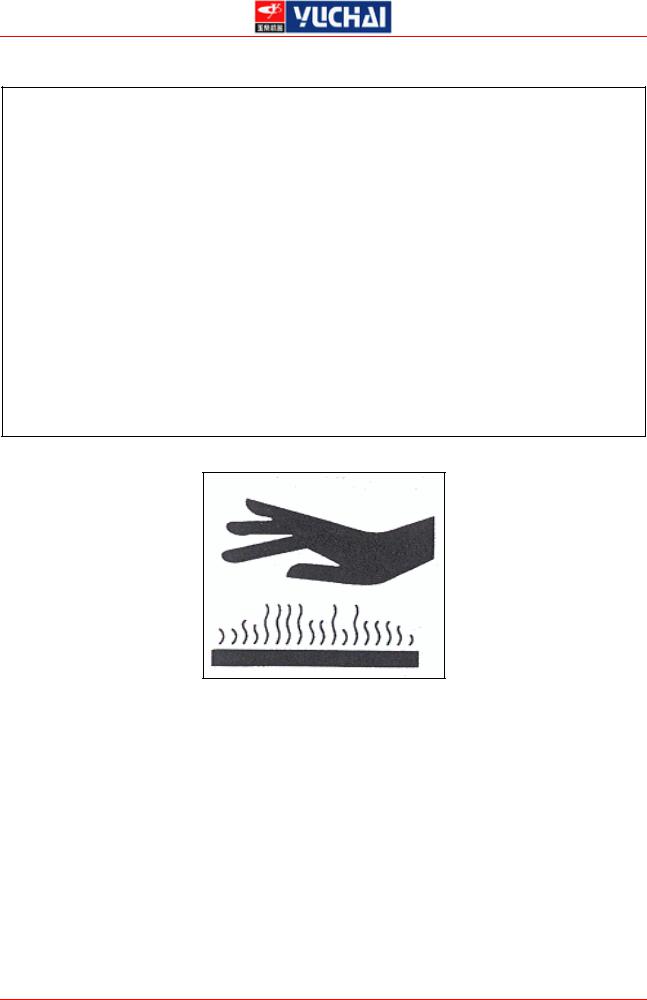
PRECAUTION WITH HIGH TEMPERATURE WORK
•The engine, muffler, radiator, hydraulic lines, sliding parts and many other parts of the machine are hot and under pressure directly after the engine is stopped. Touching these parts will cause burns so wait for the temperature drop before oil, fuel and water screw cap opening.
•To avoid hot water splash out:
1.turn off the engine;
2.waiting for the water temperature drop;
3.slowly open the screw cap to reduce the internal pressure.
•To avoid hot oil splash out:
1.turn off the engine;
2.waiting for the oil temperature drop;
3.slowly open the screw cap to reduce the internal pressure.
20

PREVENT CUTTING AND/OR CRUSHING
•do not put you hands, arms or other body parts between moving parts. I.e. between work equipment and machine body or between cylinder and moving parts or between upper structure and undercarriage or tracks. If the work equipment is moving, the free space around it is changeable it may cause severe injure or death.
FIRE EXTINGUISHER AND FIRST AID KIT
•Make sure that fire extinguisher is on board and where it is located and make sure you are able to use it.
•Make sure that first aid kit is on board.
•Known how to do in case of fire.
•Make sure to know all phone number to contact emergency assistance and first aid help.
21

ACCESSORIES PRECAUTION
•When you will use an optional accessory, first read the accessory’s operating manual and follow the instruction written in it.
•NEVER use accessories listed in this operating manual or do not authorized from YUCHAI ENGINEERING MACHINERY CO. LTD.. The non authorized accessories use may cause safety hazards and may have a negative influence on the machine’s performance and reduce the lifetime.
•Each possible injury, accident or machine bad working due to use of the unauthorized accessory, will not be responsibility of the
YUCHAI ENGINEERING MACHINERY CO. LTD.
PAY ATTENTION DO NOT CRASH THE CABIN GLASS
If the cabin glass is damaged, it is dangerous use the machine. Always change the broken glass immediately.
22
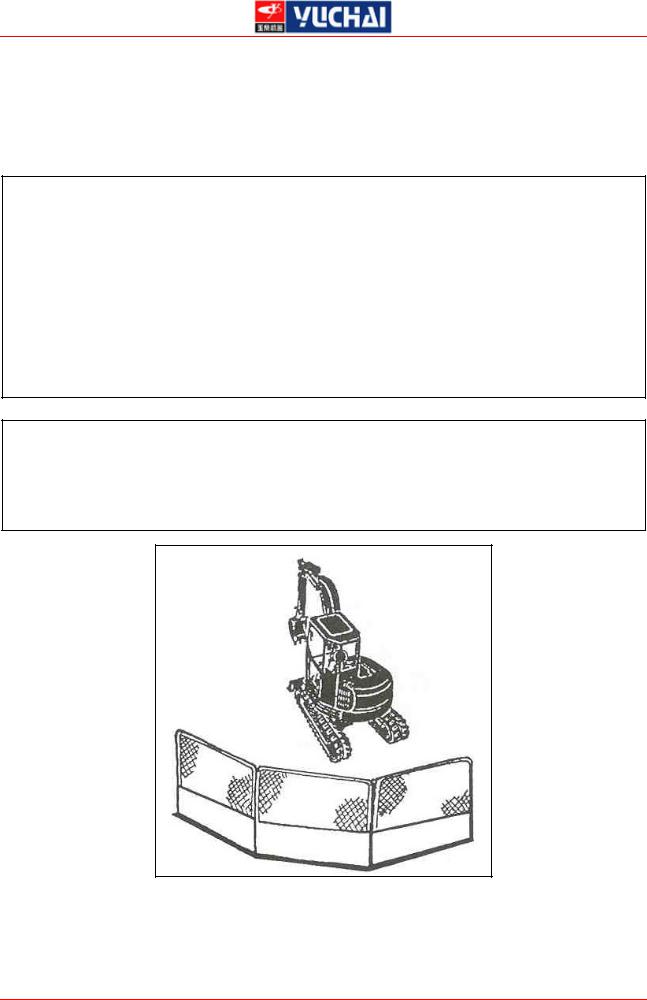
3. PRECAUTION AND SAFETY MEASURES DURING WORK
3.1 PRECAUTIONS BEFORE ENGINE START
WORKING AREA SAFETY
•Before turning on the engine check the working area, evaluate if there are abnormal condition which cause hazardous.
•Before turning on the engine check the ground condition in the working area. Choose the best working method.
•Before start work, reduce the ground slope.
•Before start work under water or run through a river, check the depth and the water flow. NEVER immerse the machine in water if the depth exceed the allowed level.
•If your work is on the road or near people passing, put a rigid repair to protect people and object also appoint a person to control the working zone.
23

•If you know that water pipe, gas pipe or electrical line were been lay underground you have to contact the owner society to identify correctly the position. Pay attention: do not cut off the pipes.
FIRE PREVENTION
•Remove wood splinter, leaves, paper and any flammable materials accumulated into the engine compartment. They may cause fire.
•Check if there are fuel, lubricant oil and/or hydraulic oil leakage. Use a clean sheet to dry oil, fuel excess or other flammable liquids escaped.
•Make sure that there is a fire extinguisher and that it works.
INSIDE THE CABIN
•Do not leave tools or spare parts on the cabin floor. They may damage or break the levers or instrument panel. Put them always into the tool box.
•Keep clean: cabin floor, instrument panel, steps, hands hold. Remove oil, grease and dirt accumulation.
24

CLOSED WORKING ZONE VENTILATION
•If it necessary turn on the engine inside a room, provide to adequate ventilation. Exhaust gas can KILL.
LIGHT AND WINDOWS PRECAUTION
•Clean out the windows and lights. Make sure to see well!
•Check if the headlamp are correctly installed for the job to do. Check if they work properly.
25

3.2 PRECAUTION WHEN THE MACHINE IS WORKING
WHEN TURN OF THE ENGINE
•before start work, walk around your machine to verify that no people or object are in the working zone.
•NEVER start the machine if any plate is put on the instrument panel.
•Play the horn before turn on the engine.
•Turn on and drive your machine from the operator’s seat only, and after have fastened your seat belt.
•Do not allow anyone to ride on any part of the machine at any time while travelling.
•Do not allow anyone to be on any part of the machine while operating.
26
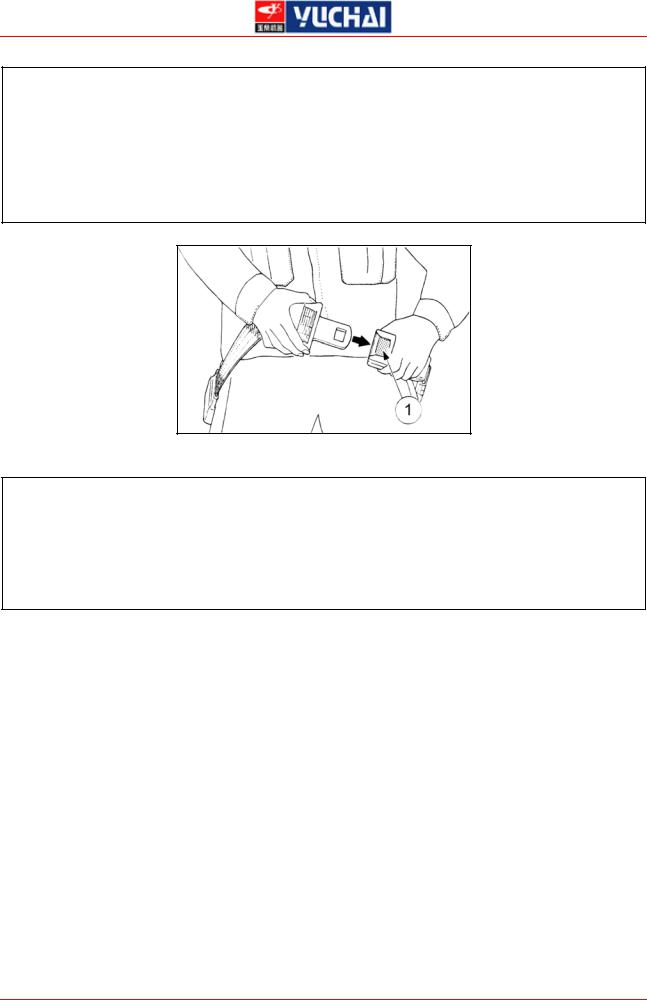
•Before start work, check the seat belt. If any part is damaged or worn, change the seat belt.
•Before start work, sit down on the operator seat and fast the seat belt.
•Stand on the seat with the seat belt fastened all the time, during work, to reduce injury if case of accident.
CHECK THE POSITION OF THE TRACKS BEFORE TRAVELLING
•Before operating the travel levers, check to make sure that the dozer blade is to the front of the operator’s seat. BE AWARE that when the dozer blade is to the rear the travel lavers operate in the opposite direction to when the dozer blade in the front.
27

BEFORE GO TO THE REVERSE MOTION OR SWING, BE SURE THAT
NOBODY IS AROUND THE WORKING ZONE
•In dangerous zone o where there is incomplete view, put always a signal.
•Make sure that nobody is inside the radius swing or rear the machine.
•Before start motion, play the horn to warn people standing or walking around the machine.
•There are blind spots to the rear of the machine, so swing the cab around before backing up to check that the area is safe and clear.
MOTION PRECAUTION
•Travel with the dozer blade folded as shown on the diagram and the bucket raised 40 ÷ 50 cm. from the ground.
•Do not slew (swing) while travelling. If you must operate the hoe attachment while travelling, operate at speeds slow enough so you have complete control at all times.
•On uneven ground, travel at low speed and avoid accelerating, stopping or changing directions abruptly.
•Avoid crossing over obstacles whenever possible. If you must do so, keep the hoe attachment close to the ground and travel slowly. Never cross obstacles if they will seriously tilt the machine (to an angle of 10° or greater).
28

Motion Position |
WRONG! |
|
|
TRAVELLING ON SLOPES
•Motion up and down the hill with severe slope (greater then 30°) IS FORBIDDEN. Great slope may cause machine roll over or slide.
•When travelling on slopes or grades, lower the bucket to a height from 20 to 30 cm off the ground. In emergencies, lower the bucket to the ground and stop the machine.
•Do not change directions or cross slopes sideways. First return to a flat surface then redirect the machine.
•On grass, dead leaves, wet metal or frozen surfaces, the machine may slide sideways even on very gentle slopes. Make sure the machine never faces sideways with respect to the slopes.
Downhill |
Uphill |
WRONG CORRECT |
29

FORBIDDEN OPERATION
•Never undercut a high bank. Be particularly alert for the possibility of a cave-in.
•Do not operate in places where there is a danger of falling rocks.
WRONG |
|
WRONG |
|
|
|
FORBIDDEN OPERATION
•Do not extend or move back the hydraulic cylinders for all them length, keep a small distance.
•Do not undercut when the trucks are not leant on the ground, otherwise you may damage the machine.
•Keep machine well back from the edge of an excavation. Avoid undercutting the machine.
30
